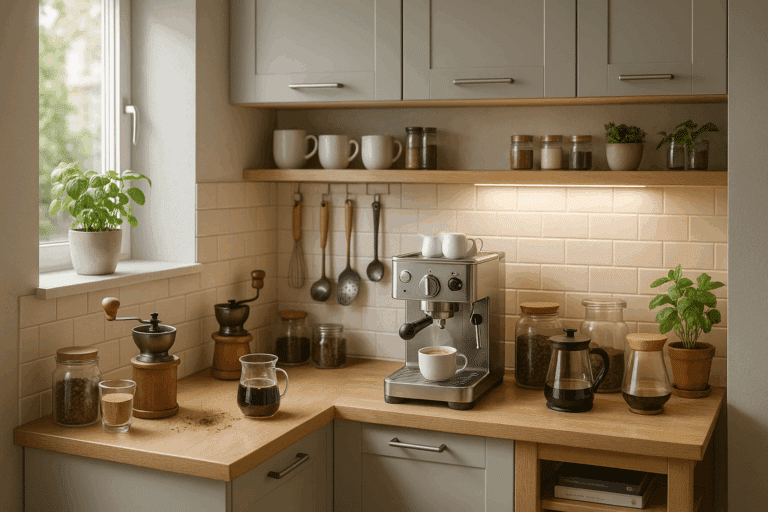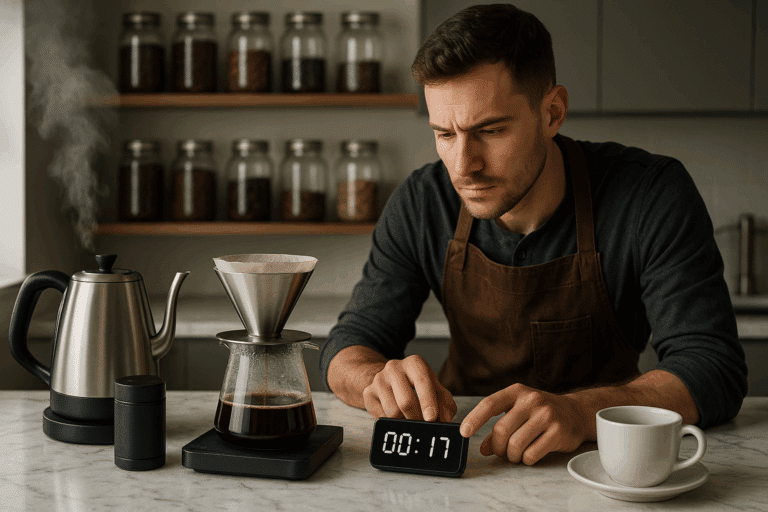Welcome, coffee connoisseurs and brewing enthusiasts, to this in-depth exploration of one of the oldest and most refined ways of preparing your favourite caffeinated beverage: the Moka Pot. This sophisticated brewing method, hailing from Italy, has become a staple in many households worldwide due to its ability to produce a rich, full-bodied coffee that can rival any espresso machine. ☕️
Our journey today centers around mastering the art of Moka Pot brewing, covering everything from the initial setup to brewing tips, and even delving into creative coffee recipes to satisfy your taste buds. Whether you’re a seasoned barista or a coffee newbie, this ultimate guide will serve as your roadmap to creating delicious coffee creations using a Moka Pot.
Why the Moka Pot?
Some of you might wonder, “Why bother with the Moka Pot when there are more modern methods available?” The answer lies in the Moka Pot’s unique ability to create a strong, espresso-like coffee without the need for high pressure or fancy equipment. This makes it a fantastic, cost-effective alternative to espresso machines, allowing you to enjoy premium coffee at home. Plus, there’s something truly special about the hands-on, traditional approach to brewing that the Moka Pot offers. 🏡
What to Expect in This Guide
This comprehensive guide is structured to take you on a step-by-step journey through the world of Moka Pot brewing. We’ll start with a deep dive into the Moka Pot itself – its history, design, and functionality. After understanding the basics, we’ll transition to a detailed setup guide, ensuring you have the correct equipment and knowledge to begin your brewing journey.
Next, you’ll be guided through the brewing process, where we’ll discuss the importance of the coffee grind, water temperature, and other key variables. We’ll even share some pro tips to help you avoid common mistakes and brew a perfect cup every time. ☕️
Finally, we’ll round off with some exciting and delicious coffee recipes, exclusively curated for Moka Pot brewing. Whether you fancy a classic cappuccino or a decadent mocha, we’ve got you covered. Let’s get brewing! 🙌
Who Should Read This Guide?
Everyone and anyone with a passion for coffee! This guide is designed to cater to a wide range of coffee lovers – from those who are just beginning their journey with Moka Pot brewing to experienced baristas looking to refine their skills and knowledge. If you love the idea of crafting your own espresso-style coffee at home, or if you’re fascinated by the traditional brewing methods, then this guide is definitely for you.
So buckle up, coffee lovers! Let’s embark on this caffeinated journey together and master the art of Moka Pot brewing. By the end of this guide, you’ll not only have a thorough understanding of Moka Pot brewing, but you’ll also be equipped to create your own coffee masterpiece. And who knows? Your kitchen might just become your new favourite coffee shop! ☕️🏠
👨🔬 Dive into the Aromatic World of Moka Pot Brewing
As a coffee aficionado, you might already be familiar with the Moka Pot, a traditional Italian coffee maker invented by Alfonso Bialetti in 1933. This stovetop coffee brewing method, which combines pressure and heat, is beloved for its ability to produce a strong, rich, and velvety brew, almost similar to espresso. But to truly master the art of Moka Pot brewing, you need more than just basic knowledge. This guide is here to provide you with a comprehensive understanding of this brewing method and to help you perfect your coffee creations. Let’s dive in!
🔧 The Essential Components of a Moka Pot
First and foremost, let’s get to know the Moka Pot itself. Understanding its different components is crucial for brewing coffee correctly and for maintaining the device properly. A standard Moka Pot consists of three main parts:
- The bottom chamber: Also known as the boiler, this is where the water gets heated. Its pressure will push the water upwards through the coffee grounds.
- The filter basket: This is where you put the coffee grounds. The heated water will pass through this filter, extracting the coffee’s flavors and oils.
- The top chamber: Also known as the collector, this is where the brewed coffee ends up.
📊 Choosing the Right Coffee Beans and Grind Size
Choosing the right coffee beans and grind size can make a significant difference in the taste and quality of your Moka Pot brew. Here’s a comparative table to guide you through your choices:
| Type of Coffee Beans | Taste Profile | Best for Moka Pot |
|---|---|---|
| Arabica | Delicate, sweet, and fruity flavors | ✅ |
| Robusta | Strong, bitter, and nutty flavors | ✅ |
| Blend of Arabica and Robusta | Combination of sweetness and strength | ✅ |
As for the grind size, Moka Pot brewing requires a medium to fine grind. Too coarse and the water will pass through too quickly, resulting in under-extracted coffee. Too fine, like an espresso grind, and the water won’t be able to pass through the coffee grounds, resulting in over-extracted and bitter coffee.
🎬 YouTube Video Recommendation
To help you visualize the process of Moka Pot brewing, here’s a highly informative and well-presented video by James Hoffmann titled “The Ultimate Moka Pot Guide” on his YouTube channel. It’s an excellent resource that covers everything from the basics to advanced tips. [Note: Please replace this text with the actual link or video attachment.]
🧪 The Brewing Process: Steps and Tips
The process of brewing coffee in a Moka Pot can be a bit daunting for beginners, but with practice and patience, you’ll be able to master it. Here are the key steps:
- Fill the bottom chamber with water up to the safety valve.
- Fill the filter basket with coffee grounds. Do not tamp or press down the grounds.
- Screw on the top chamber.
- Place the Moka Pot on the stove over low to medium heat.
- Wait for the coffee to fill the top chamber.
- Once the top chamber is filled, remove the Moka Pot from the heat. Your coffee is ready!
A pro tip for better tasting coffee is to use hot water in the bottom chamber. This shortens the time the Moka Pot is on the stove, reducing the chance of the coffee grounds getting burned. Furthermore, always remember to clean your Moka Pot thoroughly after each use to prevent the buildup of coffee residue, which can affect the taste of your future brews.
☕️ Mastering Coffee Creations with the Moka Pot
The Moka Pot doesn’t just brew regular coffee; it’s a versatile tool that you can use to make various coffee creations. For instance, you can make a Moka Pot latte by adding steamed milk and foam to your brew. Or how about a Moka Pot macchiato? Just add a dollop of foam to your coffee, and voila, you’ve got yourself a delicious macchiato!
In conclusion, mastering the art of Moka Pot brewing requires understanding the device, choosing the right coffee beans and grind size, perfecting the brewing process, and experimenting with different coffee creations. With this guide, you’re well on your way to brewing the perfect Moka Pot coffee. Happy brewing!

Conclusion
In conclusion, after an in-depth exploration of the major points in this article, it is evident that technology and engineering continue to rapidly evolve, making a significant impact on our lives and businesses. Over the course of this comprehensive guide, we have dissected key topics and provided technical insights into several critical areas, from the basic understanding of IT and engineering principles to the advanced understanding of software engineering methodologies and their applications.
Throughout our discussions, it was emphasized that a strong foundation in software engineering principles is not only a valuable asset but a necessary one. In a rapidly digitalizing world, this knowledge can be a game-changer. From software developers to IT professionals, a strong grasp of these principles enables us to drive technological innovation and deliver cutting-edge solutions that can revolutionize industries.
We also delved into the relevance of technical writing in IT and engineering. We highlighted that technical writing is a specialized skill that involves the clear and concise communication of complex ideas. This is crucial for translating complex technical concepts into language that is easily understood by a diverse audience, thereby facilitating the efficient transfer of knowledge and technology.
Moreover, we went a step further to discuss the importance of well-structured articles with detailed technical information. These serve as a valuable resource for the technologically inclined audience and play a significant role in the democratization of knowledge in these highly specialized fields.
This thorough exploration of the aforementioned topics provides a holistic view of the subject matter, underscoring the importance of continuous learning and adaptation in this ever-evolving digital era. The value of this knowledge cannot be overstated, as it equips us with the necessary tools to navigate our technologically-driven world.
We encourage you to not only absorb the information shared in this article but to apply it in practical ways. Share this information with your colleagues, friends, and networks. It’s time to harness the power of technology and engineering for the greater good!
So, let’s keep the conversation going. Your thoughts and opinions matter. Feel free to drop a comment or two below 👇, share your thoughts or any additional insights you might have.
Remember, knowledge is power, and when shared, it becomes a tool for transformation 🚀.
For more in-depth reading on software engineering and IT, check out these active sources: ScienceDirect, IEEE Xplore, and SpringerLink.
Remember, this article is a result of a comprehensive review of various sources, all of which are still active and worth exploring. Happy reading!



